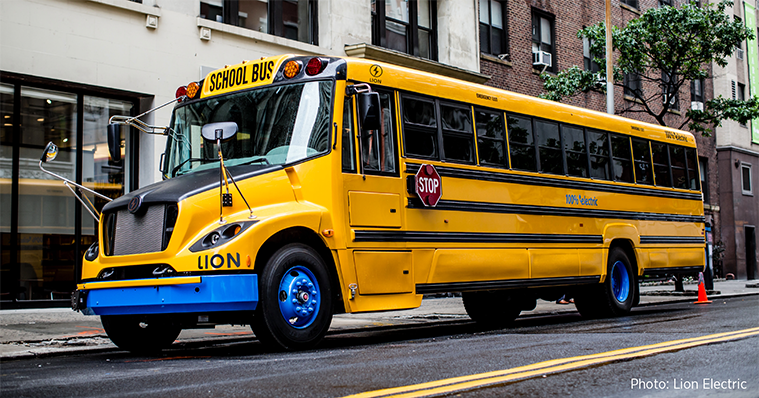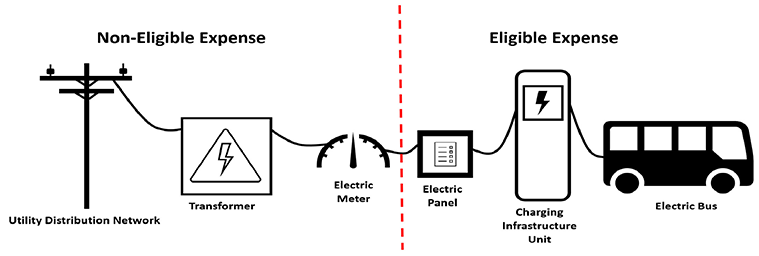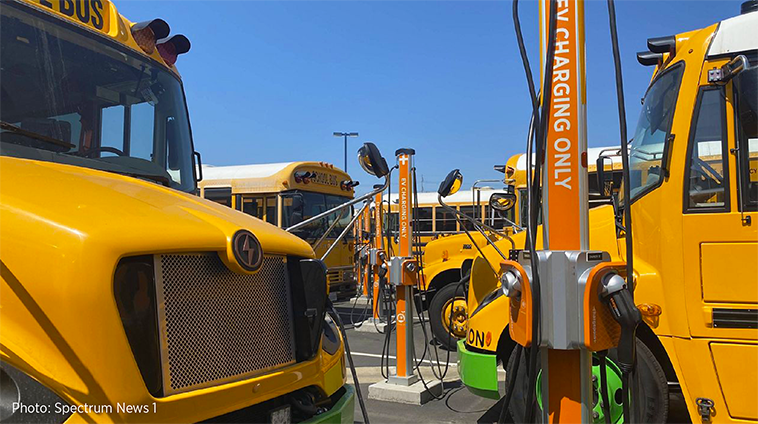
As an e-mobility trailblazer, ChargePoint firmly believes the future of transportation is zero-emission (ZE). A cleaner transportation industry is not only beneficial for our health as a society, but it also leads to more efficiency, cost reductions and improved job satisfaction. Electric school buses are a particularly smart move. Their short, fixed routes mean operating these vehicles involves few worries about range, compared with operating other fleet types. Some manufacturers estimate that each electric school bus saves 80% on fuel costs and 60% on maintenance in comparison to diesel buses. In addition, because school buses stay parked for longer times, they are a great use case for battery storage and vehicle-to-grid experimentation. Last but not least, eliminating toxic diesel fumes, linked to health problems such as asthma, protects the health of drivers and students of all ages.
While the total cost of ownership of an eBus is much lower than that of a diesel one, zero-emission buses have higher upfront costs. Luckily, programs such as the recently released 2022 EPA Clean School Bus Rebate Program help encourage and facilitate the transition to clean transportation.
We want to make it as easy as possible for our partners to make use of this opportunity, so we talked to Kevin Miller, director of Public Policy at ChargePoint, to see what the new school bus rebate program entails.
What is the recently released School Bus Rebate Program?
The Infrastructure Investment & Jobs Act (IIJA), also known as the Bipartisan Infrastructure Law (BIL), authorizes the Environmental Protection Agency (EPA) to award funding to eligible recipients for the replacement of existing school buses with zero-emission and clean school buses. It's important to highlight that this program also offers support for the charging infrastructure needed for operating a zero-emission fleet.
This initial round of funding is a rebate, meaning the winners of the lottery system will receive a refund for all eligible costs associated with their purchase of clean buses and charging infrastructure. Despite being a lottery, rebates will be prioritized for high-need school districts, tribal schools, and rural and low-income areas. The EPA would like to have at least one approved applicant within every state. The full list of priority districts can be found here.
How much can an eligible applicant get?
In 2022, $500 million will be awarded for zero-emission and clean school buses, out of the total $5 billion IIJA package planned over five years. Eligible applicants can get funding for up to 25 new school buses and the related charging infrastructure, but applications from a state cannot exceed 10% of the $500 million budget. How much an applicant can get per vehicle or charging station depends on the model and year of manufacturing, as explained in the tables below:
Maximum bus funding amount per replacement school bus

Source: EPA
Maximum charging infrastructure amount per replacement ZE school bus

Source: EPA
Can applicants also use the available funds for charging infrastructure?
Absolutely. Eligible charging infrastructure (ENERGY STAR ®–certified) can also be included in this rebate program. Successful applicants can receive up to $20,000 per vehicle for charging infrastructure, based on district and priority status. It's important to note that this rebate does not entail a one-to-one award system for buses and charging infrastructure. In other words, you do not need five chargers for five zero-emission buses.
For example: Let's say you are a school district from a high-priority area and want to purchase five zero-emission Class 7+ buses. This means you can receive up to $1,875,000 as a successful applicant. On top of this, you would also be eligible for getting up to $100,000 (5 x $20,000) for charging infrastructure.
Don't know where to start or which chargers you need? You are not alone. But no worries — we're here to help. Using the ChargePoint fleet assessment tool, we consider all your particular requirements and find the most optimal charging setup for your district. Our product portfolio includes several ENERGY STAR ® –certified charging stations, including CPF50, CT4000, CPE250 and Express Plus, and our Advanced Testing Facility ensures that our chargers meet the highest safety criteria. The new CP6000, high-power 80A 19.2kW AC fleet charger is expected to be available for the program later this year.
It's important to note that the funding for infrastructure under this rebate program is limited to the fleet side of the meter (as seen on the right side of the chart below). As the first step to infrastructure preparation, we encourage fleet operators to connect with their local utility company as well as ChargePoint to get an understanding of the current grid capabilities and upgrades required to meet their long-term eBus adoption targets.
Eligible and non-eligible expenses

Source: EPA
What are some key things to consider when applying for the Clean School Bus Rebate program?
- It's a rebate. Apply for the rebate program before you purchase any assets. Successful applicants will receive the rebate after submitting purchase orders to the manufacturer and payment requests to the EPA, according to the program deadlines. Districts should be aware that they will incur upfront costs for eligible buses and charging infrastructure. Nevertheless, rebates have the advantage of being faster and require less paperwork than other types of funding programs. We want to make it as easy as possible for interested fleet operators, so don't hesitate to get in touch if you need advice.
- Scrappage. The program requires that existing diesel vehicles be replaced with zero-emission or clean vehicles. So what do you do with the old buses? Vehicles dating from 2010 or earlier must be scrapped, and you must submit proof. Newer vehicles chosen for replacement can be donated or sold; you must also provide documentation of these transactions as well. Check out the program guide for more details.
- Consider the charging infrastructure. Charging stations should not be an afterthought. The rebate program covers charging infrastructure, enabling eligible applicants to plan their electric operation as efficiently as possible. ChargePoint EV charging experts can assist you in developing the right infrastructure plan for your specific situation.
Who can apply for this rebate program?
- State and local governmental entities responsible for providing bus service to one or more public school systems, or entities responsible for the purchase of school buses, including local education agencies (LEAs), public school districts, and state agencies that own and operate bus fleets
- Indian tribes, tribal organizations or tribally controlled schools that are responsible for providing the same services
- Nonprofit school transportation associations
- Trade associations in the student transportation industry
- Eligible contractors: For-profits or nonprofits that sell buses, chargers or maintenance equipment for buses or that finance such transactions.
What are the important deadlines for this program?
Applications for the EPA Clean School Bus Rebate Program are due Aug. 19, 2022. Successful applicants will be notified in October 2022, and they can then proceed with purchasing new buses and eligible charging infrastructure.
Until April 2023, successful applicants can submit purchase orders demonstrating that new buses and charging infrastructure have been ordered. Funds are awarded based on the actual purchased assets. Buses must be received and eligible charging infrastructure installed by October 2024.
Submit applications via SAM.gov as soon as possible in order to receive your 2022 SAM.gov applicant number in time. Private entities such as bus dealers may apply on behalf of their partners, provided that they pass the rebate directly to the customer.

ChargePoint — your partner for zero-emission school bus fleets
To widely support school bus electrification, ChargePoint collaborates with stakeholders across the whole ecosystem, from school districts to OEMs, local dealerships and beyond. Planning charging infrastructure can be a complex task, and some districts might not have the resources needed. We can assist districts when talking with local utility providers, which is essential for assessing the power grid. We can also help create an infrastructure plan specific to your needs. We've supported school districts across the United States with planning and installing their charging infrastructure most efficiently.
We also support local bus dealerships by providing advice on infrastructure choice and setup. School bus manufacturers have been working directly with districts for many years, and we have partnered with them to help speed the adoption of electric vehicles.
Many grants, incentives and other funding resources are available for the electrification of school bus fleets. Most are not mutually exclusive, and your organization can stack them to create a more comprehensive funding package. At ChargePoint, our range of turnkey e-mobility solutions includes easy-to-understand financing options. We'll also work with you to navigate complex networks of financial incentives so you can modernize your fleet operations in the most cost-effective way possible.
